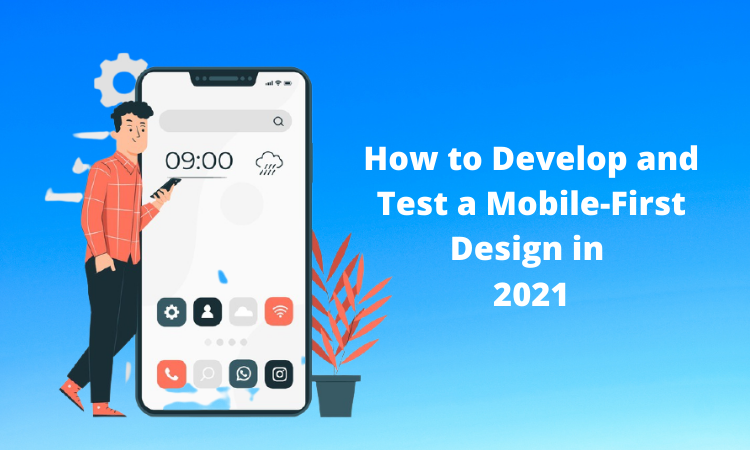Mobile users are increasing at a whopping rate day by day. The number stands at 7.1 billion in 2021. Why is it so? Smartphones come with so many applications and are easy to carry anywhere.
Also, How can web designers miss the opportunity of channelizing mobile traffic? Designers need to be amazingly innovative in designing websites for mobile devices. It leads to the coining of word mobile-first design.
Further, there is one more link to the same approach. Google launched mobile-first indexing in 2019.
Here the question arises, how to achieve mobile-first design? We’ll discuss critical strategies for
the same in the section below.
What is Mobile-first design?
The mobile-first design focuses on developing websites keeping in mind mobile devices. The traditional approach focuses on designing the website for desktops first. But, how does it matter? Desktop is a bigger screen; all web elements can take maximum space. It has a lot many differences.
But, the case is entirely different for mobiles. Mobile has less space; users are using a single finger or thumbs. The designer aims to provide the most efficient information fruitfully. Also, a web design agency can make your mobile-first design effortless.
Some designers consider responsive design the same as responsive design. No doubt, mobile websites are responsive. But, it’s not true vice versa. Responsive design adjusts itself according to different screens. However, mobile-first design is altogether a different ball game like deciding fonts, web elements size, carousels, illustrative colors, and others.
What are the steps involved in developing and testing mobile-first design?
Development of mobile-first website takes care of the mobile design and then adjusts itself to desktop. These are the steps:
Easy Navigation
Easy navigation is the foremost step to delivering seamless mobile experiences. If navigation is smooth, users will visit more pages and spend more time on your website. On the other hand, clumsy navigation is the sure-shot way to shoo away website visitors. These are the ways:
- Few options: Do you know more options confuse the mobile users? Lack of space makes it difficult to access several categories. What about fewer choices? A welcoming approach! It is easy to make choices.
- Menu: complex and short menus are a big no-no. Menus should take more expansive space to improve user interactivity and visibility. Hamburger menus can solve your purpose.
Clear call to action
CTAs are precise directions for users; what are their takeaways from the website? Otherwise, users will come and leave without taking the required actions. For mobile users, it is essential to:
- Highlight CTAs: Bigger fonts are advantageous for mobile-first design. Use dark colors to make it visually appealing.
- Short text: Long CTAs are difficult to understand. However, short CTAs are easier to digest and comprehend.
- Above the fold placement: Generally, mobile users leave the website before the bottom. The above-the-fold arrangement ensures a higher conversion ratio.
Simple content
Simple content is the key to reaching maximum mobile users. And without content, the website is lame. Well, How to arrange and create content?
- Shorter sentences: Fewer words in a line improve readability. But what happens when you create content diving deep into your niche? Scrolling and scamming information becomes a cakewalk.
- Easy Vocabulary: Do you know the average reader has a standard 6-8 grade student level? Readers can understand it. So, use simple words instead of complex ones.
Hand coverage
Have you observed how do you type on your mobile devices? It is with the thumbs. For accessing tabs or clicking links, most users use the forefinger of the right hand. It is how users interact with mobile devices.
So, placing your web elements within reach of forefingers and thumbs will deliver maximum results. You can check out the percentage of finger usage. It is 75% for the thumb. Indeed, putting CTA in a user-friendly position will get more attention.
UX and UI
Prioritizing UX and UI will improve user interaction without any other efforts. Fancy web elements like videos, podcasts are good. But only when they are in comfortable positions on the website. Make it prominent and easily clickable. In this way, users will not come to know our intentions. And they’ll perform those activities that are best for them, and we wish them to.
Testing
Testing is a crucial step for a website to perform flawlessly on mobile devices. One may think testing on one mobile screen will be sufficient. But, the reality is the opposite! Many new smartphones keep on hitting the market now and then. So, screen sizes are highly variant. Thus, designers need to test their website design on different mobiles. It will ensure the website’s smooth running across all devices.
Conclusion
Now, it’s up to you to decide which approaches to take to designing the mobile-first website. The main points are minimum space, information overload, less time, and less flexibility.


